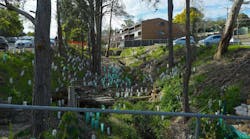
We’ve talked a lot about drought and desertification in many different parts of the world. A new technology is showing promise for getting a bit more water where it’s needed—not enough to completely alleviate the problem in drought-stricken regions or to support agriculture or revegetation on a large scale, but perhaps enough to provide potable water in amounts that will make a difference.
The process involves an absorbent powder, known as MOF (metal organic framework). As this Wall Street Journal (subscription required) article explains, it works in generally the same way that condensation forms on the outside of a cold glass. Scientists “have developed a device about the size of a Kleenex box that can suck lifesaving amounts of water out of the air even in extremely arid places. For energy, the system relies on nothing more than the power of the sun.” You can read more about the process here.
In the device currently in use, the MOF powder is embedded in a copper sheet and placed inside a box, which is left open at night to collect moisture from the atmosphere. That water is stored within the MOF’s pores. As temperatures rise during the day, the box is closed and the water in the MOF heats and turns to vapor. A condenser plate turns it back into a liquid and it is collected in a bucket underneath the device. In typical desert conditions, with 20 to 30% relative humidity, this small-scale device should capture nearly three liters of water over a 12-hour period. Much larger versions could provide enough drinking water for a residence without a potable water supply. It’s also been proposed that small versions of the device might be used in emergency situations—stored on lifeboats, for example.
But as the WSJ article notes, one scientist who has worked on the technology foresees more ambitious uses as well. “Berkeley chemist Omar Yaghi, who pioneered MOFs in the 1990s and co-authored a paper on the new research, thinks that the technology could work in less extreme circumstances too—as a low-cost, low-energy substitute for wells or municipal water systems. In his vision, homes could pull their own water right out of the air at little or no cost beyond purchasing the equipment. Homes with inadequate sun could power an electrical version by plugging it into an outlet. Those lacking electricity could use a model heated by a cooking fire.”
MOFs can be based on different types of metals, such as zirconium (very expensive) and aluminum, and Yaghi thinks the various MOFs can eventually be tailored to work most efficiently in a variety of climates.
About the Author
Janice Kaspersen
Janice Kaspersen is the former editor of Erosion Control and Stormwater magazines.

